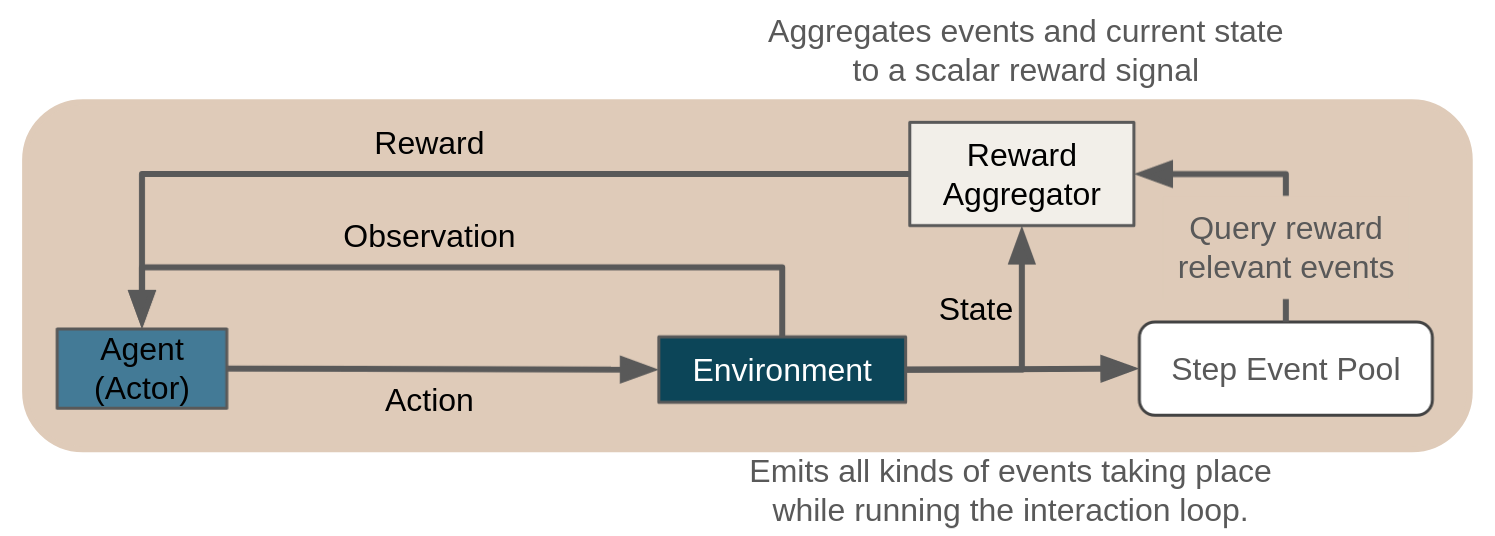Customizing / Shaping Rewards¶
In a reinforcement learning problem the overall goal is defined via an appropriate reward signal. In particular, reward is attributed to certain, problem specific key events and the current environment state. During the training process the agent then has to discover a policy (behaviour) that maximizes the cumulative future reward over time. In case of a meaningful reward signal such a policy will be able to successfully address the decision problem at hand.

From a technical perspective, reward customization in Maze is based on the environment state
in combination with the general event system
(which also serves other purposes), and is implemented via
RewardAggregators.
In summary, after each step, the reward aggregator gets access to the environment state,
along with all the events the environment dispatched
during the step (e.g., a new item was replenished to inventory), and can then calculate arbitrary rewards
based on these. This means it is possible to modify and shape the reward signal based on
different events and their characteristics by plugging in different reward aggregators
without further modifying the environment.
Below we show how to get started with reward customization by configuring the CoreEnv and by implementing a custom reward.
List of Features¶
Maze event-based reward computation allows the following:
Easy experimentation with different reward signals.
Implementation of custom rewards without the need to modify the original environment (simulation).
Computing simple rewards based on environment state, or using the full flexibility of observing all events from the last step
Combining multiple different objectives into one multi-objective reward signal.
Computation of multiple rewards in the same env, each based on a different set of components (multi agent).
Configuring the CoreEnv¶
The following config snippet shows how to specify reward computation for a CoreEnv
via the field reward_aggregator.
You only have to set the reference path of the RewardAggregator and reward computation will be
carried out accordingly in all experiments based on this config.
For further details on the remaining entries of this config you can read up on how to customize Core- and MazeEnvs.
# @package env
_target_: maze_envs.logistics.cutting_2d.env.maze_env.Cutting2DEnvironment
# parametrizes the core environment (simulation)
core_env:
max_pieces_in_inventory: 1000
raw_piece_size: [100, 100]
demand_generator:
_target_: mixed_periodic
n_raw_pieces: 3
m_demanded_pieces: 10
rotate: True
# defines how rewards are computed
reward_aggregator:
_target_: maze_envs.logistics.cutting_2d.reward.default.DefaultRewardAggregator
# defines the conversion of actions to executions
action_conversion
- _target_: maze_envs.logistics.cutting_2d.space_interfaces.action_conversion.dict.ActionConversion
max_pieces_in_inventory: 1000
# defines the conversion of states to observations
observation_conversion:
- _target_: maze_envs.logistics.cutting_2d.space_interfaces.observation_conversion.dict.ObservationConversion
max_pieces_in_inventory: 1000
raw_piece_size: [100, 100]
Implementing a Custom Reward¶
This section contains a concrete implementation of a reward aggregator for the built-in cutting environment (which bases its reward solely on the events from the last step, as that is more suitable than checking current environment state).
In summary, the reward aggregator first declares which events it is interested in (the get_interfaces method). At the end of the step, after all the events have been accumulated, the reward aggregator is asked to calculate the reward (the summarize_reward method). This is the core of the reward computation – you can see how the events are queried and the reward assembled based on their values.
"""Assigns negative reward for relying on raw pieces for delivering an order."""
from typing import List, Optional
from maze.core.annotations import override
from maze.core.env.maze_state import MazeStateType
from maze.core.events.pubsub import Subscriber
from maze_envs.logistics.cutting_2d.env.events import InventoryEvents
from maze.core.env.reward import RewardAggregatorInterface
class RawPieceUsageRewardAggregator(RewardAggregatorInterface):
"""
Reward scheme for the 2D cutting env penalizing raw piece usage.
:param reward_scale: Reward scaling factor.
"""
def __init__(self, reward_scale: float):
super().__init__()
self.reward_scale = reward_scale
@override(Subscriber)
def get_interfaces(self) -> List:
"""
Specification of the event interfaces this subscriber wants to receive events from.
Every subscriber must implement this configuration method.
:return: A list of interface classes.
"""
return [InventoryEvents]
@override(RewardAggregatorInterface)
def summarize_reward(self, maze_state: Optional[MazeStateType] = None) -> float:
"""
Summarize reward based on the orders and pieces to cut, and return it as a scalar.
:param maze_state: Not used by this reward aggregator.
:return: the summarized scalar reward.
"""
# iterate replenishment events and assign reward accordingly
reward = 0.0
for _ in self.query_events(InventoryEvents.piece_replenished):
reward -= 1.0
# rescale reward with provided factor
reward *= self.reward_scale
return reward
When adding a new reward aggregator you (1) have to implement the
RewardAggregatorInterface and
(2) make sure that it is accessible within your Python path.
Besides that you only have to provide the reference path of the reward_aggregator to use:
reward_aggregator:
_target_: my_project.custom_reward.RawPieceUsageRewardAggregator
reward_scale: 0.1
Where to Go Next¶
Additional options for customizing environments can be found under the entry “Environment Customization” in the sidebar.
For further technical details we highly recommend to read up on the Maze event system.
To see another application of the event system you can read up on the Maze logging system.